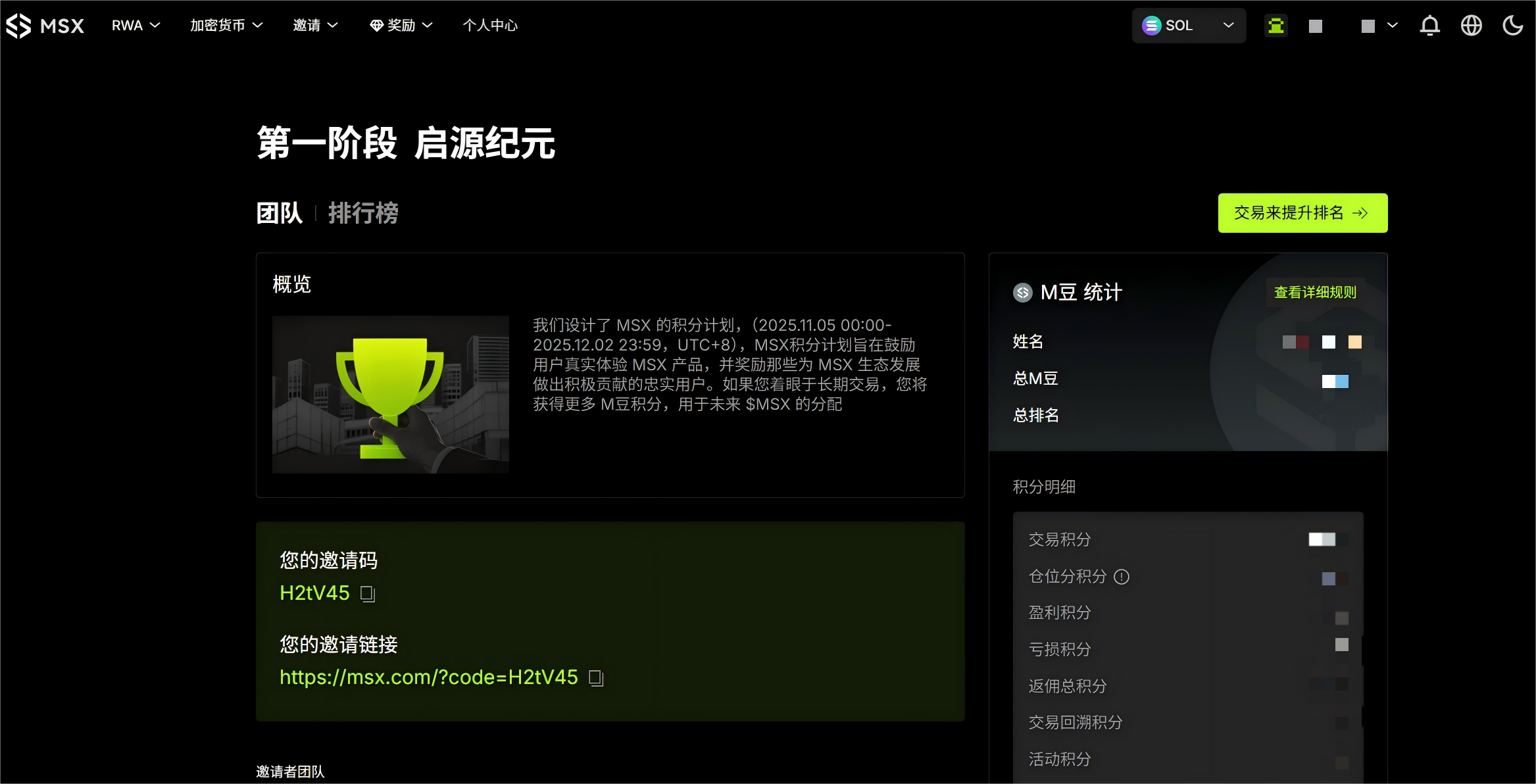MSX Season 1 Gold Rush Guide: Deconstructing the Points Calculation Logic and How to Maximize Your M-Bean Earnings
- 核心观点:MSX启动积分赛季激励用户参与。
- 关键要素:
- 交易、持仓、盈亏决定基础积分。
- 团队Boost提供1.05-1.5倍加成。
- 两级推荐佣金持续产生被动收益。
- 市场影响:提升平台活跃度与用户粘性。
- 时效性标注:短期影响
Written by: Tyler
Decentralized RWA trading platform MSX officially launched its points season program today, aiming to reward loyal users who have made positive contributions to the development of the MSX ecosystem. Users can earn M Credits through trading US stock spot, futures, and spot-to-spot futures products on MSX and use them directly for future MSX token distributions.
This guide will provide an in-depth breakdown of the impact factors, distribution mechanism, team Boost, and two-tier referral commission algorithms for MSX Season 1, along with calculation examples. Whether you are an active trader or a long-term holder, you can learn techniques to maximize your points earnings through this tutorial, preparing you for future ecosystem incentives and token allocation.
I. MSX Points Season S1 and "M&M's"
1. MSX Points Season S1 Introduction
The MSX Points Season is a long-term incentive program launched by MSX for active users, designed to reward users who make genuine contributions to ecosystem growth and trading activity.
Season 1, the first season, will last for 28 days (4 weeks), starting at 00:00 on November 5th and continuing until 23:59 on December 2nd (UTC+8 time).
2. What are "M&M's"?
M Credit is the core unit of equity used by the MSX platform in Season 1 to measure and incentivize users' real contributions, and it can be directly mapped to future MSX token distribution and ecosystem benefits.
There is no upper limit to the total amount of M&M's in Season 1, but the system allocates them based on trading and contribution data. It adopts a multi-dimensional comprehensive incentive model, and its output depends not only on trading volume, but also on multiple factors such as position value, holding time, profit and loss performance, team collaboration and referral contributions.
3. M&M's Calculation Logic
MSX compiles daily user data on trading, positions, and activities. Specifically, it focuses on three core user behaviors: trading, holdings (position size/time/profit/loss), and activities (team boost/referrals). Trading and holdings constitute the base score, while activity points are key to achieving "excess returns" on top of the base score.
Total score = (trading points + position points + average profit/loss points + average loss points) * team Boost bonus + referral commission contribution points. M&M's score is the result of multiplying this total score by a fixed multiplier (assumed to be 10,000 in this article).
1. Basic Points (Trading Points + Holding Points)
During Season 1, any user who trades in US stock spot, US stock futures, or cryptocurrency futures will earn trading points based on their actual trading volume. Both opening and closing positions are counted towards the total trading volume. In short, the more you trade, the more points you earn. This is the only truth of Season 1.
In addition, there are holding points, which are divided into two dimensions: daily position points (position value + holding time) and daily realized profit and loss. If multiple positions are involved, the data for each position must be calculated separately to obtain the average value for the day.
- Daily Position Score: The value of a user's daily holdings, specifically calculated as Σ (average asset value_i * time period_i) * 0.01, where asset value is in units of U and time period is in units of min. In other words, the larger the position and the longer the holding period, the more points are awarded.
- Daily realized profit and loss: Calculated based on daily realized profit and loss (excluding funding fees/miscellaneous fees), with positive profits adding points and losses also having a corresponding ratio (not 1:1), increasing the fault tolerance rate. This means that every real trade and every market participation you make is considered part of the ecosystem contribution.
In short, the points for each transaction are directly linked to the trading volume, holding time, and daily profit/loss. The more trading volume, the larger the position, the longer the holding time, and the greater the profit/loss, the more points you will earn.
2. Team Boost
In addition, the Team Boost is an amplifier for achieving points multiplication in Season 1, enabling "excess returns" on top of the base points. Simply put, your personal base points (trading volume + position points + profit and loss points) are only the first layer, while Team Boost can "multiply" the returns of this layer.
Boost levels depend on the total daily M&A snapshots of the entire team. The higher the team's contribution, the higher the level and the greater the corresponding multiplier. Currently, the Boost range is approximately between 1.05× and 1.5×. As the team's overall activity and trading volume increase, the multiplier will also rise accordingly.
In other words, you not only have to "earn money yourself", but also lead your team to "earn money together" - the more team points you have, the more your personal points can be multiplied, which is the most leveraged part of Season 1.
3. Referral Rewards
In addition to trading and team bonuses, the referral mechanism is also an important part of the M&M's system.
The current season supports two levels of invite relationships: L1 (direct invite): you will receive 10% of their base points; L2 (indirect invite): you will receive 5% of their base points.
The invitation mechanism itself is not complicated, but the potential for profit is huge. As long as your downline users continue to trade, hold positions, and earn points, you can continuously obtain a "passive points flow". Therefore, building a team and inviting real trading users in the early stages is one of the key strategies to improve long-term points ranking.
4. Other follow-up activities and historical transaction retrospectives
It is understood that the official team will launch limited-time tasks and trading-themed events from time to time. Completing designated actions will earn extra M&B points. In addition, there will be historical transaction retrospectives (a snapshot has been taken, and the specific conversion method, coverage and distribution schedule will be subject to subsequent announcements).
II. M&M's Step-by-Step Guide: From Acquiring to Viewing
Currently, the cyclical recovery of the US stock market is bringing a new round of structural opportunities. In particular, with the Nasdaq and S&P 500 continuing to rise, on-chain RWA US stock trading has become an important channel for investors to capture market alpha. The MSX points season also provides a "double alpha" opportunity to capture US stock gains and platform incentives.
This multi-dimensional mechanism ensures that users receive reasonable rewards for every real transaction, making M&M's both a reflection of "transaction contribution" and a "long-term incentive." This chapter will also guide new users on how to start trading quickly on the MSX platform from scratch and begin accumulating and viewing their M&M's.
First, open the MSX official website , click on "Connect Wallet" in the upper right corner, select any address from your preferred networks (Solana, BNB Chain, Ethereum, and Base are supported), and sign in the wallet pop-up window. You can then automatically register or log in without needing a phone number or email address.
Then click "Deposit Now," select the network you want to deposit into, and transfer USDT/USDC to the corresponding account's dedicated deposit address. After the deposit is complete, you can perform three main types of trading activities. Each transaction will be automatically credited to the M-Beans points system:

It is worth noting that in order to maintain the fairness of the points system and prevent invalid machine-generated trading and high-frequency trading from diluting the rights and interests of real users, the MSX points system has set up key anti-fraud mechanisms, including not counting any holding behavior with a holding time of less than 5 seconds —the time interval between a user's buy and sell transactions (for the same asset).
After entering the [Rewards - Points] page, you can see detailed information such as your personal M-Beans earned in Season 1 and your overall ranking (as shown in the image below), including:
- The "Team" page displays the user's team information, invitation code/invitation link, and member details;
- The "Leaderboard" page displays the ranking of M&A points across the entire site, as well as detailed breakdowns of points earned through transactions, positions, holdings, and referral commissions.

Note that binding an invitation code is a prerequisite for activating Team Boost and referral commissions. It is recommended to complete the binding before your first transaction (you can use the invitation link to complete the registration and transaction, which will automatically bind the code).
M&M's are settled the following day – automatically updated at 10:00 (UTC+8) the next day, with the system recalculating based on the actual trading and holdings of the previous day; Team Boost uses a T+2 update mechanism: M&M's points are settled at 10:00 on T+1 day, and team level and Boost are updated at 10:00 on T+2 day.



